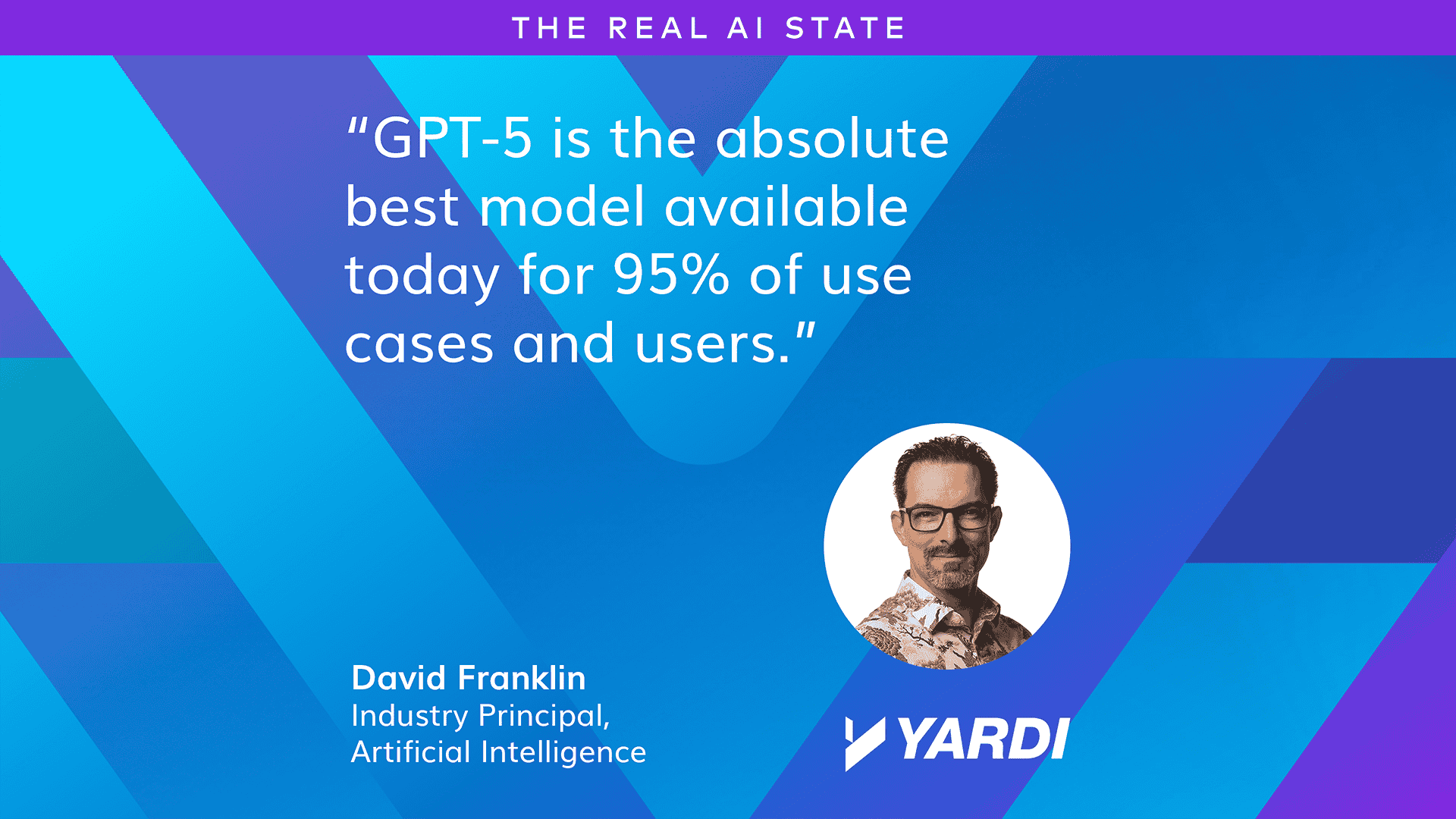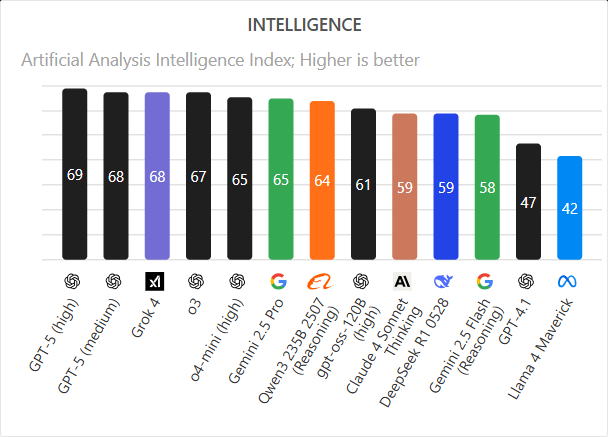By David Franklin on August 19, 2025 in Technology

It’s finally here! After months of teasing, OpenAI has finally released GPT-5, and boy is it amazing. Even so, does it fall short of expectations? The hype cycle surrounding AI in general and specifically OpenAI, the leader in the space, has led to a bar being set so high that even a tremendous leap can’t clear it. Many early reviews have been less than entirely positive, with some reviewers even declaring they hate it.
The truth of the matter is this: GPT-5 is the absolute best model available today for 95% of use cases and users. Just because it didn’t live up to everyone’s expectations of what would come next, doesn’t mean that it is anything less than the next step forward for AI in general. It’s smart, personable, simple and cheap. These are the attributes that matter most and will drive the success of the product going forward. If you want all the details, you can watch the release video.
There’s so much to discuss, I’m only going to focus on GPT-5 in this post.
Let’s dig in!
GPT-5 is really smart
With the release of GPT-5, OpenAI has moved back into the lead across almost every benchmark and regained its position as top dog. Here’s a chart from Artificial Analysis, which tests everything from reasoning to coding ability, so you can see how GPT-5 stacks up against the competition.

Topping the leaderboards matters mainly because it gives some objective criteria for comparing models. A lot of benchmarks don’t directly translate to real-world use cases, so they should be taken with a grain of salt. There’s also what is known as a “vibes check” that reviewers use to give a sense of what it feels like to use a model. Is it friendly? Does it follow instructions well? How good does it feel to use it? The feedback I’ve heard is that GPT-5 really is a great new model, but it’s still just on par with Gemini Pro 2.5 and Claude Opus 4.1 (which are both fantastic models).
GPT-5 is not AGI
You’ll notice that while GPT-5 is better than everything else, it’s only a little bit better. There’s no huge leap in capability, which is why many people were disappointed. This is not a new form of AGI (Artificial General Intelligence) which would be far beyond anything we have today, and that’s OK!
Also, be aware that GPT-5 comes in different “flavors,” with some options for how much thinking they do and how much memory they consume, which is why you see it listed multiple times. The smaller versions are less capable, but they’re cheaper and faster while still being better than many other competitors.
The fact that we haven’t achieved the AGI revolution that Sam Altman has been promising is not a problem. Yes, the optics are bad because it’s been overhyped and overblown, but that shouldn’t be the deciding factor as to whether or not it’s a useful tool and a step in the right direction.
GPT-5 excels in key domains
While GPT-5 remains highly capable across a wide range of topics, OpenAI has clearly concentrated on a few areas where it wants the model to lead — computer programming, healthcare and science.
Computer programming is one of the most competitive frontiers in AI, with OpenAI going head-to-head against Anthropic’s Claude Opus 4.1. In its release video, OpenAI demonstrated GPT-5 completing sophisticated coding tasks that would typically require an experienced software engineer. While some developers still favor Claude, GPT-5 is effectively neck-and-neck, offering powerful tools for code generation, debugging and explanation.
Healthcare is another priority. Investigating medical issues is already one of the most common uses for ChatGPT, and GPT-5 is positioned as a true expert, helping patients understand symptoms, interpret what their doctors tell them and advocate for themselves. For example, preparing questions before an appointment or clarifying complex lab results.
In science, GPT-5’s advanced reasoning and analytical abilities make it a valuable partner for researchers. It can assist with literature reviews, experiment design and data interpretation, accelerating progress across disciplines from biology to physics.
With over 700 million monthly active users, most are everyday people asking general questions, while a smaller but influential segment consists of professionals who demand exceptional accuracy and depth in their answers. GPT-5 manages to serve both audiences: accessible and friendly for casual use, yet deeply capable for specialized, high-stakes work.
GPT-5 is cheap
GPT-5 is incredibly inexpensive compared with the competition. Below, take a look at a price comparison by Simon Willison.
| Model | Input $/m | Output $/m |
| Claude Opus 4.1 | 15.00 | 75.00 |
| Claude Sonnet 4 | 3.00 | 15.00 |
| Grok 4 | 3.00 | 15.00 |
| Gemini 2.5 Pro (>200,000) | 2.50 | 15.00 |
| GPT-4o | 2.50 | 10.00 |
| GPT-4.1 | 2.00 | 8.00 |
| o3 | 2.00 | 8.00 |
| Gemini 2.5 Pro (<200,000) | 1.25 | 10.00 |
| GPT-5 | 1.25 | 10.00 |
| o4-mini | 1.10 | 4.40 |
| Claude 3.5 Haiku | 0.80 | 4.00 |
| GPT-4.1 mini | 0.40 | 1.60 |
| Gemini 2.5 Flash | 0.30 | 2.50 |
| Grok 3 Mini | 0.30 | 0.50 |
| GPT-5 Mini | 0.25 | 2.00 |
| GPT-4o mini | 0.15 | 0.60 |
| Gemini 2.5 Flash-Lite | 0.10 | 0.40 |
| GPT-4.1 Nano | 0.10 | 0.40 |
| Amazon Nova Lite | 0.06 | 0.24 |
| GPT-5 Nano | 0.05 | 0.40 |
| Amazon Nova Micro | 0.035 | 0.14 |
Let’s say that you believe Claude Opus 4.1 is marginally better at doing software development than GPT-5, so you decide to use Claude as your model. It’ll cost you twelve times as much for that marginal improvement in capability. That just doesn’t make any sense.
By pricing GPT-5 so low, OpenAI is making their toolset accessible to a much larger audience while also preparing for the massive token usage that agentic AI will demand. This is a strong signal that the future will involve a lot of agents acting autonomously to take on more and more complex tasks.
GPT-5 feels like a true, independent agent
GPT-5 is intrinsically agentic, meaning that it’s exceptionally good at following instructions, acting on its own, and spending the time needed to complete tasks that can take a long time. Just like prior versions, it can accomplish “deep research” type tasks that require a lot of searching, thinking and analyzing.
We’ve already seen this capability in earlier versions, where you could select the Deep Research mode to force the model to spend extra time and tokens answering questions. Now that type of capability is being folded into the default behavior of the model as needed. Combined with Canvas, the virtual computing environment that ChatGPT uses, this will open up incredible new use cases that are only possible because the model can write its own code. It turns out that computers are better at using computers than people are!
With the rise of “Agentic AI”, what we’re really seeing is a mechanism for making AI more useful. The first way AI became more useful was by simply being smarter. Now that we’re approaching superhuman intelligence, the next step is to give AI the ability to do more in the world. That’s really what agentic AI is all about. ChatGPT running the GPT-5 model is now able to go and do more in the world, not only because it’s smarter, but because it can keep track of long-running tasks and manage its own internal state to ensure a successful outcome.
GPT-5 will replace all prior models
What is significantly different from prior versions is that GPT-5 combines the “thinking” versions of the model with the immediate, chat-style responses provided by “non-thinking” models. In the past, there were many different models with confusing names and versions: GPT-4o, 4.1, 4.5, o1, o3, o4 and so on. Some were ‘thinking’ models, others were not.
With GPT-5, there’s a single model that will choose how much thinking it needs to do to answer the question posed. End users who use ChatGPT and want to wait for a deeply reasoned answer can prompt the model to “think really hard,” and it will do just that.
I will say that this has drawn a lot of criticism from the developer community, where they are used to having explicit control and are willing to accept the complexity and nuance of different models in exchange for more precision about how the model will behave. The reality is that OpenAI still has explicit controls in the API, and for the majority of users, who aren’t developers, this makes a lot more sense.
GPT-5 won’t just say no
As with most advanced technologies, LLMs can be used for good or bad. OpenAI has attempted to prevent their LLMs from answering questions on sensitive topics such as providing instructions on how to build a bomb, for example. In the past, if you asked a question that the model was uncomfortable with, it would flat out refuse to answer.
Let’s say that you’re a researcher working at a biomedical laboratory. Perhaps you’re trying to develop better vaccines. If you tried to engage ChatGPT in a conversation about engineering viruses, you would most likely run into the filter and simply get shut down, ending the conversation before you could get to the safe, productive part of your work.
GPT-5 is more nuanced about how it handles sensitive topics and can give partial responses and explanations for why it doesn’t want to answer certain questions, rather than flat out refusing. This makes it much easier to discuss potentially dangerous topics, and the AI feels more understanding and collaborative.
Conclusion
AI continues to improve, and OpenAI is leading the pack. Despite the naysayers, this is a great new release that I’m excited for you all to try.
Thank you all for tuning in. Please subscribe to be notified whenever a new post comes out and we look forward to seeing you on the next one.
Stay curious, my friends!
Disclaimer
This article is for general information purposes only. The opinions, analysis and commentary expressed are not and cannot be relied on as legal advice, and do not necessarily reflect the views of Yardi Systems, Inc., or any of its affiliates.


